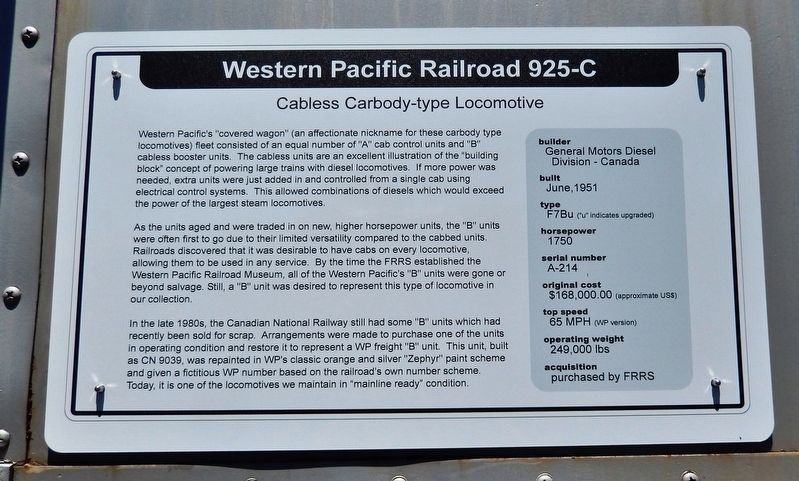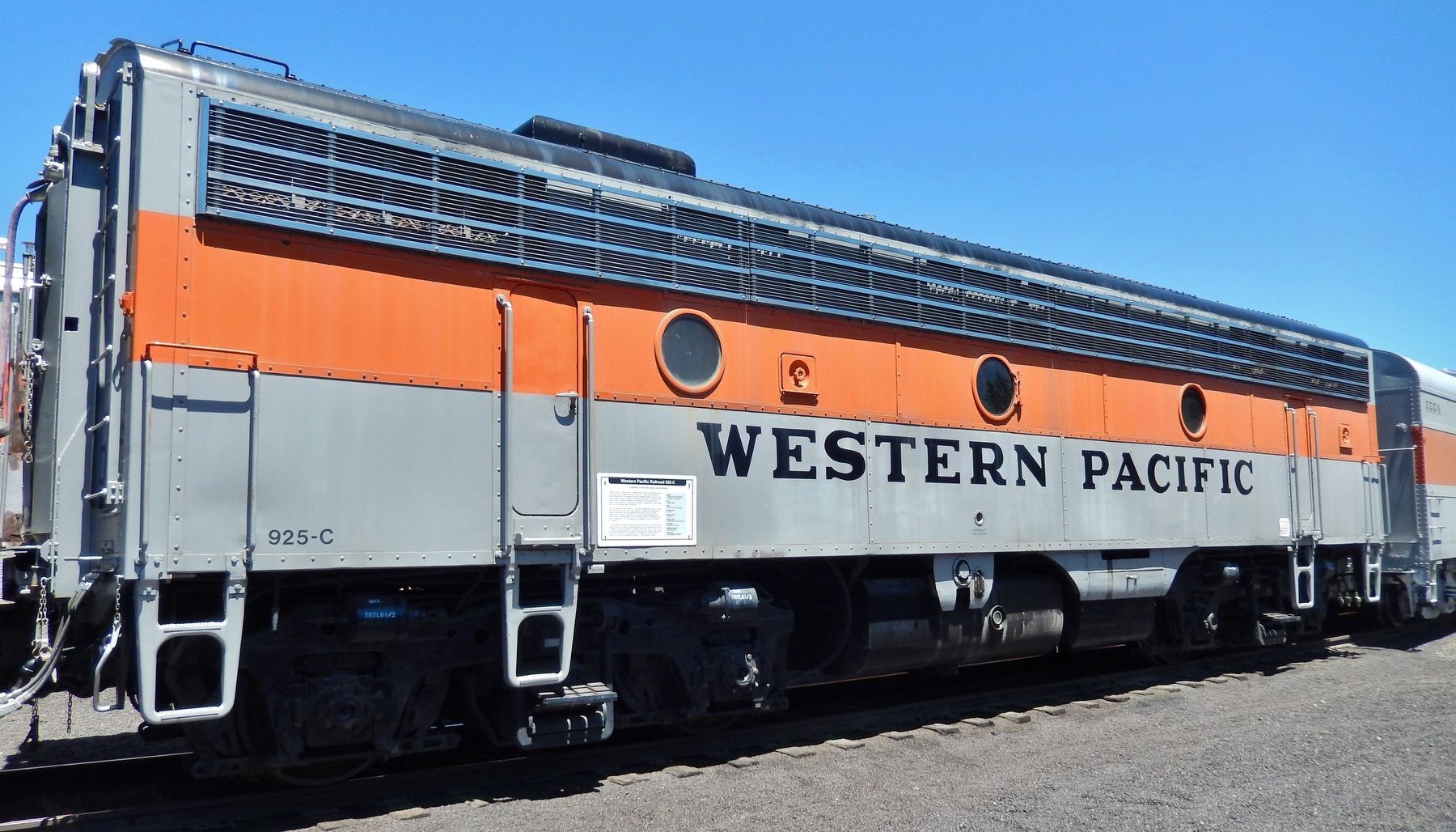Portola in Plumas County, California — The American West (Pacific Coastal)
Western Pacific Railroad 925-C
Cabless Carbody-type Locomotive
As the units aged and were traded in on new, higher horsepower units, the "B" units were often first to go due to their limited versatility compared to the cabbed units. Railroads discovered that it was desirable to have cabs on every locomotive, allowing them to be used in any service. By the time the FRRS established the Western Pacific Railroad Museum, all of the Western Pacific's "B" units were gone or beyond salvage. Still, a "B" unit was desired to represent this type of locomotive in our collection.
In the late 1980s, the Canadian National Railway still had some "B" units which had recently been sold for scrap. Arrangements were made to purchase one of the units in operating condition and restore it to represent a WP freight "B" unit. This unit, built as CN 9039, was repainted in WP's classic orange and silver "Zephyr" paint scheme and given a fictitious WP number based on the railroad's own number scheme. Today, it is one of the locomotives we maintain in "mainline ready" condition.
builder • General Motors Diesel Division - Canada
built • June, 1951
type • F7Bu ("u" indicates upgraded)
horsepower • 1750
serial number • A-214
original cost • $168,000.00 (approximate US$)
top speed • 65 MPH (WP version)
operating weight • 249,000 lbs
acquisition • purchased by FRRS
Erected by Western Pacific Railroad Museum.
Topics. This historical marker is listed in this topic list: Railroads & Streetcars. A significant historical month for this entry is June 1951.
Location. 39° 48.207′ N, 120° 28.649′ W. Marker is in Portola, California, in Plumas County. Marker can be reached from Western Pacific Way, ¼ mile west of Main Street. Marker is mounted directly on the subject locomotive, on exhibit in the Western Pacific Railroad Museum yard. Touch for map. Marker is at or near this postal address: 700 Western Pacific Way, Portola CA 96122, United States of America. Touch for directions.
Other nearby markers. At least 8 other markers are within walking distance of this marker. Western Pacific Railroad 805-A (a few steps from this marker); Sacramento Northern Railway 712 (a few steps from this marker); Western Pacific Railroad 428
(within shouting distance of this marker); Western Pacific Railroad 484 (within shouting distance of this marker); Central California Traction Company 24 (within shouting distance of this marker); Western Pacific Railroad 501 (within shouting distance of this marker); Southern Pacific Railroad MW208 (about 300 feet away, measured in a direct line); Western Pacific 106 "Charles O. Sweetwood" (about 400 feet away). Touch for a list and map of all markers in Portola.
Also see . . .
1. Western Pacific 925-C. The reasoning behind its "fictitious number": WP's last F7B was numbered 924-C, so we numbered this one 925-C (the "B" suffix units had steam generators, the "C" suffix ones did not, and ours does not have a steam generator, hence the "C" suffix). (Submitted on December 27, 2020, by Cosmos Mariner of Cape Canaveral, Florida.)
2. B Unit / Booster Unit / Cabless Unit (Wikipedia). The reasons railroads ordered B units included the fact that a B unit was slightly cheaper. With no driving cab, B units lack windshields, crew seats, radios, heating, and air conditioning. There would also be no toilets, which were usually found in the short hood of an A unit. Many railroads soon came to the opinion that the lower cost of a B unit did not offset the lack of operational flexibility. Few B units have been built in the last 40 years. (Submitted on December 27, 2020, by Cosmos Mariner of Cape Canaveral, Florida.)
Credits. This page was last revised on December 27, 2020. It was originally submitted on December 25, 2020, by Cosmos Mariner of Cape Canaveral, Florida. This page has been viewed 100 times since then and 11 times this year. Photos: 1, 2. submitted on December 27, 2020, by Cosmos Mariner of Cape Canaveral, Florida.

